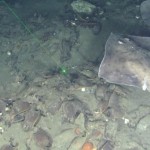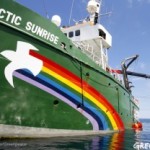Part one of four in a series about Greenpeace recent manned submersible expedition to two of the largest submarine canyons in the world, the Pribilof and Zhemchug Canyons in the Bering Sea off the west coast of Alaska.
 One of the core principles taught to me and other students at Duke’s Nicholas School of the Environment is that the environmental movement at the turn of the century will be marked, or perhaps best remembered, by “the rise of non-governmental organizations (NGO’s)” in the public policy arena. We learned that NGO activity expanded to fill a gap in civil society left open by a global retraction of federal and state responsibility at the end of the 20th century.
One of the core principles taught to me and other students at Duke’s Nicholas School of the Environment is that the environmental movement at the turn of the century will be marked, or perhaps best remembered, by “the rise of non-governmental organizations (NGO’s)” in the public policy arena. We learned that NGO activity expanded to fill a gap in civil society left open by a global retraction of federal and state responsibility at the end of the 20th century.
Before the 1990’s, NGOs and non-profits were largely viewed as advocates and watchdogs. By the turn of the millennium, NGO’s had earned a place at the decision making table. Advocate groups took their place alongside bureaucrats, scientists, and resource users in federal and international forums. Organizations like Greenpeace, World Wildlife Fund, and Doctors without Borders had leveraged their private funding base, flexibility, and field capacity to form strategic alliances with nation-states and development banks to win victories that penetrated federal and state policy. NGO’s evolved into media savvy political caucuses willing to embrace the unrepresented masses, including animals, ecosystems, poor indigenous people, and private donors around the world.
This is relevant because fragile deep-sea ecosystems suffer direct and indirect threats from commercial fisheries, munitions dumping, and seafloor mining that we so often detail here. But state and federal authorities would be unlikely to combat these threats without NGO’s pushing the agenda. Currently, only a handful of environmental organizations include deep-sea habitats in their conservation agenda. Marine Conservation Biology Institute and Oceana work to protect deep-sea corals and other habitats from bottom trawling in the North Pacific. The World Wildlife Fund is working to protect seamounts in the Mediterranean. Natural Resource Defense Council is winning the war against low-frequency sonar in California state waters. Some of these groups are united through the Deep Sea Conservation Coalition. But, still, as these NGO’s rise to met these threats, only one big international NGO is assembling teams to survey deep-sea habitats with manned submersibles launched from their own ship- and that’s Greenpeace.
Last month, Greenpeace raised the bar for pro-active ocean exploration by an NGO to inform better ocean management by outfitting their own “green” vessel, the Esperanza, with two Deep Worker manned submersibles depth rated to 600m. The Bering Witness Expedition partnered with experienced scientists from NOAA, Smithsonian, MBARI, and Harte Research Institute (among others). They took the particularly bold step of certifying Greenpeace staff as submarine pilots. Timo had this to say: “The subs are surprisingly nimble and stable, and the navigation of them … is amazingly intuitive.” The research team made 25 dives over the course of the expedition collecting tissue samples and high definition video for presentation to the North Pacific Marine Fisheries Council in October. There were no major problems reported.
Hey, if they can drive a submarine, so can you, right? Perhaps, but let it be known that these are the saltiest of dogs. Greenpeace has been an ocean loving organization since their first actions taking small boats out to try to stop nuclear testing in Amchitka and the South Pacific. Over their 35 year history, they helped to ban drift nets and ocean dumping. Their focus evolved from protecting single species to protecting ecosystems. They developed a stronger understanding of the need to involve – and defend – coastal communities and small-scale fishermen in efforts to protect marine ecosystems.
A few years ago, Alaska’s native communities asked Greenpeace for help in protecting Pribilof Canyon. They see the canyon as essential habitat for many of the species they have depended upon for generation. When Greenpeace ocean specialist John Hocevar discussed his intentions with Larry Merculief, a native leader from the Pribilof Islands, his response was “ecosystem based management?!? We’ve been doing that for ten thousand years!”
In the course of the next few posts I will provide a quick summary of some of the important findings from the Bering Witness Expedition, introduce you to two of the sub pilots in exclusive DSN interviews, and hip you to a few links likely to yield continuous insight and entertainment about the deep-sea.
The Bering Witness website is a good place to start educating yourself about this mission, if you’re interested. The site’s thick with photos, videos, daily logs, and other information. Hopefully, this is just the beginning. Deep Sea News sends our warmest congratulations out to the team.







Great Job on the Greenpeace series. Its nice to hear about the actual research they are doing and the cool discoveries and not the “hooligan” stories I often hear in the mainstream news. I will be looking for the papers to come out!
And if they need any capable taxonomists, send them my way! Especially that anemone in part, it looks like one I currently have under description…
What a nice article. Thanks! I had no idea Greenpeace was doing Deep Sea Research. I also linked to Greenpeace’s website and ended up reading a crazy beautiful story and meeting Diek, one of the Esperanza’s crew members. I loved the internet! Read on.
http://members.greenpeace.org/blog/diek
Please go to
http://members.greenpeace.org/gpblog/at/ESP/bio/
Some of these bio’s are hilarious. What a nice fun bunch of people!
Just another thanks for the heads-up on this. I also was unawares Greenpeace was doing this research–which is a bit embarrassing since I’ve been actively supporting Greenpeace since sometime in the 1980s.
Kevin, I can inquire for you, if you wish. I would have guessed that anemone was Liponema brevicornis, the pom pom anemone.
Well my adviser has a famous saying that I’ve adopted when doing taxonomy. “When you assume, you make ass out of u and me“. Anyways, always looking for Unid specimens!
Yep, heard that. Didn’t know anemones were part of your game.
Haven’t I told you peter? I am describing 7 new species of anemone and a zoanthid from vents in the SW Pacific with colleagues at Ohio State. Part of a grant I got last year from the ChEss project at Census of Marine Life (my first grant!)
We are especially in need of zoanthinds for phylogenetic work is anyone out there has some on shelfs. Especially Sphenopus or Neozoanthus or anything likely new. We would like to take a look at them!
My shrimp description is still in review.